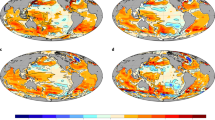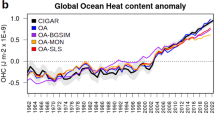Abstract
The global ocean stores more than 90% of the heat associated with observed greenhouse-gas-attributed global warming1,2,3,4. Using satellite altimetry observations and a large suite of climate models, we conclude that observed estimates of 0–700 dbar global ocean warming since 1970 are likely biased low. This underestimation is attributed to poor sampling of the Southern Hemisphere, and limitations of the analysis methods that conservatively estimate temperature changes in data-sparse regions5,6,7. We find that the partitioning of northern and southern hemispheric simulated sea surface height changes are consistent with precise altimeter observations, whereas the hemispheric partitioning of simulated upper-ocean warming is inconsistent with observed in-situ-based ocean heat content estimates. Relying on the close correspondence between hemispheric-scale ocean heat content and steric changes, we adjust the poorly constrained Southern Hemisphere observed warming estimates so that hemispheric ratios are consistent with the broad range of modelled results. These adjustments yield large increases (2.2–7.1 × 1022 J 35 yr−1) to current global upper-ocean heat content change estimates, and have important implications for sea level, the planetary energy budget and climate sensitivity assessments.
This is a preview of subscription content, access via your institution
Access options
Subscribe to this journal
Receive 12 print issues and online access
$209.00 per year
only $17.42 per issue
Buy this article
- Purchase on Springer Link
- Instant access to full article PDF
Prices may be subject to local taxes which are calculated during checkout





Similar content being viewed by others
References
Levitus, S., Antonov, J. & Boyer, T. Warming of the world ocean, 1955–2003. Geophys. Res. Lett. 32, L02604 (2005).
Church, J. A. et al. Revisiting the Earth’s sea-level and energy budgets from 1961 to 2008. Geophys. Res. Lett. 38, L18601 (2011).
Otto, A. et al. Energy budget constraints on climate response. Nature Geosci. 6, 415–416 (2013).
Rhein, M. et al. in Climate Change 2013: The Physical Science Basis (eds Stocker, T. F. et al.) Ch. 3, 255–315 (IPCC, Cambridge Univ. Press, 2013).
Gregory, J. M., Banks, H. T., Stott, P. A., Lowe, J. A. & Palmer, M. D. Simulated and observed decadal variability in ocean heat content. Geophys. Res. Lett. 31, L15312 (2004).
Gouretski, V. & Koltermann, K. P. How much is the ocean really warming? Geophys. Res. Lett. 34, L01610 (2007).
Gille, S. T. Decadal-scale temperature trends in the southern hemisphere ocean. J. Clim. 21, 4749–4765 (2008).
Domingues, C. M. et al. Improved estimates of upper-ocean warming and multi-decadal sea-level rise. Nature 453, 1090–1093 (2008).
Lyman, J. M. & Johnson, G. C. Estimating annual global upper-ocean heat content anomalies despite irregular in situ ocean sampling*. J. Clim. 21, 5629–5641 (2008).
Ishii, M. & Kimoto, M. Reevaluation of historical ocean heat content variations with time-varying XBT and MBT depth bias corrections. J. Oceanogr. 65, 287–299 (2009).
Levitus, S. et al. World ocean heat content and thermosteric sea level change (0–2000 m), 1955–2010. Geophys. Res. Lett. 39, L10603 (2012).
Lyman, J. M. & Johnson, G. C. Estimating global ocean heat content changes in the upper 1800 m since 1950 and the influence of climatology choice*. J. Clim. 27, 1945–1957 (2014).
Wijffels, S. E. et al. Changing expendable bathythermograph fall rates and their impact on estimates of thermosteric sea level rise. J. Clim. 21, 5657–5672 (2008).
Cowley, R., Wijffels, S., Cheng, L., Boyer, T. & Kizu, S. Biases in expendable bathythermograph data: A new view based on historical side-by-side comparisons. J. Atmos. Ocean. Technol. 30, 1195–1225 (2013).
Gille, S. T. Warming of the southern ocean since the 1950s. Science 295, 1275–1277 (2002).
Aoki, S., Bindoff, N. L. & Church, J. A. Interdecadal water mass changes in the southern ocean between 30° E and 160° E. Geophys. Res. Lett. 32, L07607 (2005).
Alory, G., Wijffels, S. & Meyers, G. Observed temperature trends in the Indian Ocean over 1960–1999 and associated mechanisms. Geophys. Res. Lett. 34, L02606 (2007).
Durack, P. J. & Wijffels, S. E. Fifty-year trends in global ocean salinities and their relationship to broad-scale warming. J. Clim. 23, 4342–4362 (2010).
Barnett, T. P. et al. Penetration of human-induced warming into the world’s oceans. Science 309, 284–287 (2005).
AchutaRao, K. M. et al. Variability of ocean heat uptake: Reconciling observations and models. J. Geophys. Res. 111, C05019 (2006).
Gleckler, P. J. et al. Human-induced global ocean warming on multidecadal timescales. Nature Clim. Change 2, 524–529 (2012).
Pierce, D. W., Gleckler, P. J., Barnett, T. P., Santer, B. D. & Durack, P. J. The fingerprint of human-induced changes in the ocean’s salinity and temperature fields. Geophys. Res. Lett. 39, L21704 (2012).
Smith, D. M. & Murphy, J. M. An objective ocean temperature and salinity analysis using covariances from a global climate model. J. Geophys. Res. 112, C02022 (2007).
Banks, H. T. & Gregory, J. M. Mechanisms of ocean heat uptake in a coupled climate model and the implications for tracer based predictions of ocean heat uptake. Geophys. Res. Lett. 33, L07608 (2006).
Fyfe, J. C. Southern ocean warming due to human influence. Geophys. Res. Lett. 33, L19701 (2006).
Talley, L. D. Shallow, intermediate, and deep overturning components of the global heat budget. J. Phys. Oceanogr. 33, 530–560 (2003).
Church, J. A. et al. in Climate Change 2013: The Physical Science Basis (eds Stocker, T. F. et al.) Ch. 13, 1137–1216 (IPCC, Cambridge Univ. Press, 2013).
Church, J. A., White, N. J., Coleman, R., Lambeck, K. & Mitrovica, J. X. Estimates of the regional distribution of sea level rise over the 1950–2000 period. J. Clim. 17, 2609–2625 (2004).
Roemmich, D. & Gilson, J. The 2004–2008 mean and annual cycle of temperature, salinity, and steric height in the global ocean from the Argo program. Prog. Oceanogr. 82, 81–100 (2009).
Flato, G. et al. in Climate Change 2013: The Physical Science Basis (eds Stocker, T. F. et al.) Ch. 9, 741–866 (IPCC, Cambridge Univ. Press, 2013).
Acknowledgements
The work of P.J.D., P.J.G. and K.E.T. from Lawrence Livermore National Laboratory is a contribution to the US Department of Energy, Office of Science, Climate and Environmental Sciences Division, Regional and Global Climate Modeling Program under contract DE-AC52-07NA27344. The work of F.W.L. was performed at the Jet Propulsion Laboratory, California Institute of Technology and is supported by NASA ROSES Physical Oceanography grant NNN13D462T and the NASA Sea Level Change Team (NSLCT). We thank numerous colleagues from the Program for Climate Model Diagnosis and Intercomparison (PCMDI) for valuable feedback and input into this project. We also thank J. Durack of the University of California, San Francisco (USA), M. V. Durack of educAID (Australia), T. P. Boyer from the National Oceanographic Data Center, Silver Spring (USA), C. M. Domingues from the Antarctic Climate and Ecosystems CRC, Hobart (Australia) and J. A. Church from the Centre for Australian Weather and Climate Research, Hobart (Australia). We acknowledge the sources of observed data used in this study: D. Smith and J. Murphy (Smi07), C. M. Domingues (Dom08), M. Ishii and M. Kimoto (Ish09), S. Levitus and T. Boyer (Lev12) and the International Argo Program and the national programs that contribute to it. We acknowledge the World Climate Research Programme’s Working Group on Coupled Modelling, which is responsible for CMIP, and we thank the climate modelling groups (listed in Supplementary Tables 1 and 2) for producing and making available their model output. For CMIP the US Department of Energy’s Program for Climate Model Diagnosis and Intercomparison provides coordinating support and led development of software infrastructure in partnership with the Global Organization for Earth System Science Portals. The DW10 data presented in this study can be downloaded from the CSIRO Ocean Change website at www.cmar.csiro.au/oceanchange. LLNL Release #: LLNL-JRNL-651841.
Author information
Authors and Affiliations
Contributions
P.J.D. completed the OHC analysis, P.J.G. assisted in the OHC analysis and F.W.L. completed the SSH analysis. All authors assisted with interpretation and shared responsibility for writing the manuscript.
Corresponding author
Ethics declarations
Competing interests
The authors declare no competing financial interests.
Supplementary information
Rights and permissions
About this article
Cite this article
Durack, P., Gleckler, P., Landerer, F. et al. Quantifying underestimates of long-term upper-ocean warming. Nature Clim Change 4, 999–1005 (2014). https://doi.org/10.1038/nclimate2389
Received:
Accepted:
Published:
Issue Date:
DOI: https://doi.org/10.1038/nclimate2389
This article is cited by
-
Atmospheric responses to the interannual variability of sea surface temperature front in the summertime Southern Ocean
Climate Dynamics (2024)
-
Drivers and distribution of global ocean heat uptake over the last half century
Nature Communications (2022)
-
Future Southern Ocean warming linked to projected ENSO variability
Nature Climate Change (2022)
-
Past and future ocean warming
Nature Reviews Earth & Environment (2022)
-
Stratospheric ozone depletion and tropospheric ozone increases drive Southern Ocean interior warming
Nature Climate Change (2022)



